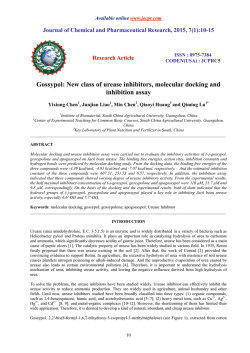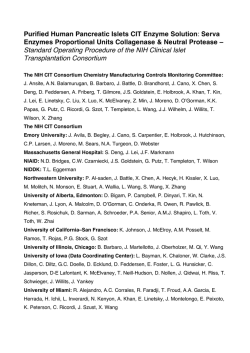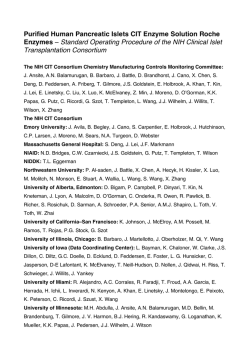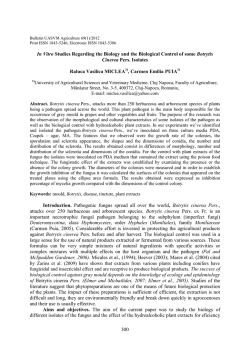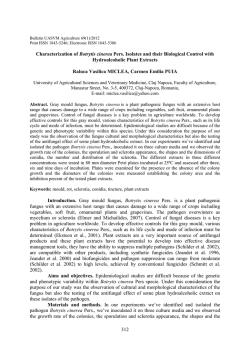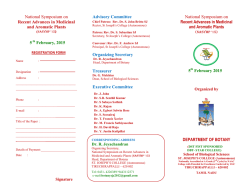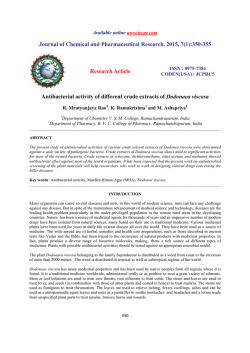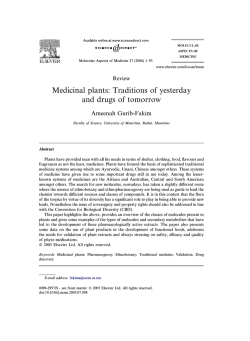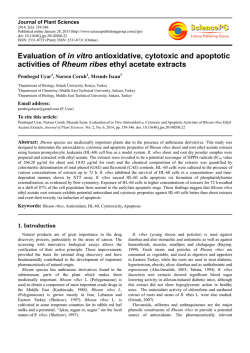
Bioactive compounds and pharmacological potential of Rosa indica
Available online at www.scholarsresearchlibrary.com Scholars Research Library Der Pharmacia Lettre, 2015, 7 (1):179-184 (http://scholarsresearchlibrary.com/archive.html) ISSN 0975-5071 USA CODEN: DPLEB4 Bioactive compounds and pharmacological potential of Rosa indica L. and Psidium guajava L. methanol extracts as antiurease and anticollagenase agents Sheema Bai, Leena Seasotiya, Anupma Malik, Pooja Bharti and Sunita Dalal* Department of Biotechnology, Kurukshetra University, Kurukshetra, Haryana, India _____________________________________________________________________________________________ ABSTRACT Rosaindica and Psidiumguajava methanol extracts were tested for their effect on urease and collagenase enzyme by using phenol hypochlorite method and gelatin digestion assay, respectively. Among the two plant extracts evaluated, the highest inhibitory activity against Jack bean urease was exerted by R. indica(47.11%), while for collagenase P. guajava showed complete inhibition of enzyme at concentration of 10 mg/ml. Both the R. indica and P. guajava extracts showed potent urease (IC50 value: 1.42 and 2.08 mg/ml) and collagenase (IC50 value: 7.29 and 4.10 mg/ml) inhibition activity. The GC-MS analysis provided different peaks of twelve compounds ofR. indica and twenty three of P.guajava. Quinic acid (43.12%),Pyrogallol (21.92%), and 5-hydroxymethylfurfural (11.52%) were the major compounds in R. Indica while, Pyrogallol (27.64%), Isogeraniol (15.41%), and 1-Butanol, 3-methyl (10.92%) were found in P. guajava. R. indica and P. guajava extracts exhibited potent inhibitory activity against urease and collagenase enzyme, which could be attributed to the presence of various bioactive constituents identified by GCMS.The findings of our study endorse the use of these plants for further studies to determine their potential in management of pathologies caused by tested enzymes. Keywords: Jack bean urease, collagenase, Pyrogallol, Quinicacid, GC-MS. _____________________________________________________________________________________________ INTRODUCTION Urease (EC3.5.1.5), the first enzyme crystallized from Jack bean (Canavaliaensiformis), is secreted by variety of bacteria in human body where it catalyzes the hydrolysis of urea to ammonia and carbon dioxide at a rate approximately 1014 times, the rate of uncatalyzed reaction. High concentrations of ammonia causes rise in pH which leads to major pathologies like gastrointestinal disorders, urolithiasis, ammonia and hepatic encephalopathy, hepatic coma, urinary catheter encrustation [1, 2] and Parkinson΄s disease [3]. The necessity to treat such infections has stimulated intensive studies on various groups of urease inhibitors. In the near past, a number of urease inhibitors have been investigated, such as phosphorodiamidates, hydroxamic acid derivatives, hydroxyurea, rabeprazole, lansoprazole, omeprazole, quinines, and thiol-compounds, but most of these compounds are too toxic or unstable, to allow their use in vivo. Thus, the search is still on for novel urease inhibitors with promising levels of activity [3]. Collagenases (EC 3.4.24…) are endopeptidases, capable of degrading the triple-helical region of native collagen, which is susceptible to attack by other peptidases only after initiation of cleavage by collagenase [4]. Uncontrolled proteolysis by collagenase contributes to abnormal development and to the generation of many pathological conditions including wrinkle formation, skin ulceration, metastasis, arthritis, chronic inflammation, osteoporosis, periodontal disease, tumor invasion, cardiovascular disease, nephritis, neurological disease, breakdown of blood brain barrier, gastric ulcer, corneal ulceration, liver fibrosis, emphysema, fibrotic lung disease, etc.[5].Therefore, 179 Scholar Research Library Sunita Dalal et al Der Pharmacia Lettre, 2015, 7 (1):179-184 ______________________________________________________________________________ collagenase represents an attractive pharmacological drug target and its inhibition has become a promising therapeutic strategy for the treatment of such diseases[5].At present, several collagenase inhibitors are under clinical trials and it is expected that the use of these inhibitors would develop a new approach in management of inflammatory processes in addition to traditional drugs. Most of these inhibitors are synthetic peptides, chemically modified tetracyclines, bisphosphonates or compounds isolated from natural sources. However, most of these drugs are reported to exert side effects such as musculoskeletal pain in tendons and joints [6]. So, seeking novel and efficacious collagenase inhibitors with good bioavailability and low toxicity is very substantial. Several hundred genera of plants and relevant prescriptions are used medicinally for treatment and prevention of various disorders in different countries which have stood the test of time, and therefore, modern medicines have not been able to replace most of them. But the full potential of both urease and collagenase inhibitors from natural sources has not yet been fully explored. In present investigation we selected, Rosa indica L. (Rosaceae) and PsidiumguajavaL. (Myrtaceae), two important medicinal plants, on the basis of their antibacterial activity against urease enzyme producing (Personal communication, unpublished) and other epidermal infections causing bacterial strains. R.indica L. is a perennial flower shrub. In the Indian system of medicine, various rose preparations are used in treatment of sore throat, bacterial infections, enlarged tonsils, cardiac troubles, eye disease, and gall stones, [7]. P.guajavaL. is a phytotherapic plant used in folk medicine that is believed to have active components that help to treat and manage various diseases. Many parts of the plant have been used in traditional medicine to manage conditions like gastroenteritis, vomiting, diarrhea, wounds, ulcers, toothache, sore throat, inflamed gums, and a number of other conditions [8, 9]. Therefore, it is reasonable to expect a variety of bioactive compounds in these plants with great therapeutic potential. Hence, for the discovery of lead compounds for use as therapeutic drugs, the active principals in these plants need to be identified [10]. Considering all these aspects, the present study was undertaken to evaluate the antiurease and anticollagenase activity along with chemical composition of methanol extracts of R. indica and P. guajava. MATERIALS AND METHODS 2.1 Chemicals and glassware Urease Type IX (Specific activity: 50,000 to 100,000 units/g) from Canavaliaensiformis(L.) DC. (Fabaceae) commonly known as Jack Bean and Collagenase Type 1 (Specific activity: 50,000 to 100,000 units/g) from Clostridium histolyticum were purchased from Sigma Aldrich. All other chemicals were of analytical grade. 2.2 Collection of plant material The plant materials were collected from Northern rural areas (around Rewari region) of Haryana, India.Further identification and authentication of the specimens was done from Dr. Narendera Yadav Department of Botany, Kurukshetra University, Kurukshetra. The plant materials were thoroughly washed with tap water followed by distilled water, then dried under shade and ground into fine powder. After sieving (80 mesh) theywere transferred to air-tight polyethylene zipper bags, labeled and stored till further use. Voucher plant specimens were deposited at the Wild Life Institute of India, Dehradun, under specimen number GS 427 for P. guajava and GS 448 for R. indica. 2.3 Preparation of Plant Extracts The powdered plant parts (100 g) were soaked in methanol (100 ml) in a clean and dry reagent bottle covered with a lid at 37°C for 24 hrs. The extraction was done by hot continuous Soxhlet extraction for 48 hrs. Resulting extracts in were evaporated and concentrated to dryness using the rotatory evaporator at 50°C. The extracts were stored at -4°C till further uses. 2.4 Urease Activity and Inhibition Study The enzyme activity and inhibition was measured through catalytic effects of urease on urea by measuring change in absorbance in the absence and in the presence of inhibitor at 640 nm, using spectrophotometer (T60 UV visible). Both the extracts were tested for urease inhibition activity in a concentration range of 100 to 1000 µg/ml. Thiourea was used as standard inhibitor. For urease inhibition assay, after addition of 10 ml of phosphate buffer to accurate weight of enzyme, sonication was performed for 60 sec., followed by centrifugation and absorbance of upper 180 Scholar Research Library Sunita Dalal et al Der Pharmacia Lettre, 2015, 7 (1):179-184 ______________________________________________________________________________ solution was measured at 280 nm. By using equation A= εbc, where c is concentration of solution (mol/L), b is length of the UV cell and ε represents molar absorptivity, we can calculate the concentration of initial urease solution. After proper dilution, the concentration of enzyme solution was adjusted to 2 mg/ml. Reaction mixture comprising 1.2 ml of phosphate buffer solution (10 mM potassium phosphate, 10 mM lithium chloride and 1 mM Ethylenediaminetetraacetic acid, pH 8.2 at 37°C), 0.2 ml of urease enzyme solution, and 0.1 ml of extracts were subjected to incubation for 5 min. After pre-incubation 0.5 ml (66 mM) of urea was added to the reaction mixture, and incubated for 20 min. Urease activity was determined by measuring the ammonia released during the reaction by modified spectrophotometric method described by Weatherburn [11]. Briefly, 1 ml each of phenol reagent (1% w/v phenol and 0.005% w/v sodium nitroprusside) and an alkaline reagent (1% w/v NaOH and 0.075% active chloride NaOCl) were added to each test tube. The increase in absorbance at 640 nm was measured after 30 min, all reactions being performed in triplicate in a final volume of 4 ml. The concentration of extracts that inhibited the hydrolysis of substrate by 50% (IC50) was determined through monitoring the inhibition effect of various concentrations of extracts in the assay. 2.4.1 Data analysis The results (change in absorbance per min) were processed by using MS Excel. The extent of the enzymatic reaction was calculated based on the following equation: I% = 100–(T/ C*100) Where I (%) is the inhibition of the enzyme, T (test) is the absorbance of the tested sample (plant extract or positive control in the solvent) in the presence of enzyme, C (control) is the absorbance of the solvent in the presence of enzyme. IC50 values were determined from the concentration response curves. 2.5 Anticollagenase assay Collagenase inhibition was performed by gelatin digestion assay[12] with slight modifications, which is basically an indirect assay involving the digestion of gelatin by bacterial collagenase-1. Agarose solution (1%) was prepared in collagenase buffer (50 mM TrisHCl, 10 mM CaCl2, 0.15 M NaCl, 7.8 pH) with 0.15% gelatin and allowed to solidify in wells of 6-well plate (4 ml/well) for 45 min at room temperature. After solidification, wells of 4 mm were made in gelatin-agarose gel with the help of a borer. Different concentrations of extracts (30µl) were incubated with 50µl of bacterial collagenase-1 (0.2 mg/ml) in 50 µl of collagenase buffer for 30 min. The reaction products (50 µl) were loaded into the well and incubated for 18 h at 37°C. The degree of gelatin digestion in agarose gel was visualized by Coomassie Blue staining. Following destaining, the area of light translucent zone over blue background was determined to estimate collagenase activity. EDTA was used as positive control. 2.6 GC-MS analysis GC-MS technique was used in this study to identify the phytocomponents present in the extracts. The extracts were analyzed by GC-MS using Shimadzu Mass Spectrometer-2010 series. 1 µl of sample was injected in GC-MS equipped with a split injector and a PE Auto system XL gas chromatograph interfaced with a Turbo-mass spectrometric mass selective detector system. The MS was operated in the EI mode (70 eV). Helium was employed as the carrier gas and its flow rate was adjusted to 1.2 ml/min. The analytical column connected to the system was an Rtx-5 capillary column (length-60m × 0.25mm i.d., 0.25 µm film thickness). The column head pressure was adjusted to 196.6 kPa. Column temperature programmed from 100˚C (2 min) to 200˚C at10˚C/min and from 200˚ to 300˚C at 15˚C/min withhold time 5 and 22 min respectively. A solvent delay of 6 min was selected. The injector temperature was set at 260°C. The GC-MS interface was maintained at 280°C. The MS was operated in the ACQ mode scanning from m/z 40 to 600.0. In the full scan mode, electron ionization (EI) mass spectra in the range of 40600 (m/z) were recorded at electron energy of 70 eV. Compounds were identified by comparing mass spectra with library of the National Institute of Standard and Technology (NIST), USA/Wiley. RESULTS AND DISCUSSION 3.1 Urease inhibition study The discovery of potent and safe urease inhibitors has been a very important area of pharmaceutical research due to the involvement of urease in different pathological conditions [13]. The plants have been widely used for their therapeutic effects in relieving the infections caused by urease enzyme [14]. The previous literature revealed the isolation of urease inhibitors from some plants and herbs like,Allium sativumL. (Amaryllidaceae), 181 Scholar Research Library Sunita Dalal et al Der Pharmacia Lettre, 2015, 7 (1):179-184 ______________________________________________________________________________ HypericumoblongifoliumWall. (Hypericaceae), Melilotusindicus(Linn.) and Allium cepa and P. guajava[15, 16, 17].Urease inhibition activity of some Pakistani traditional medicinal plants have also been reported recently [18]. Mild potential of Aerva.javanica (Burm. f.) Juss.exSchult. (Amaranthacea) has been reported against ulcer [19]. But the full potential of urease inhibition has not yet been fully explored. In this work, the urease inhibitory activity of the plant samples was evaluated against jack bean urease by using phenol hypochlorite method and the results are exhibited in Figure I. Urease inhibition 90 80 % Inhibition 70 60 50 40 30 20 10 0 0 200 400 600 800 1000 1200 Conc. (µg/ml) R. indica P. guajava Thiourea Figure I. Inhibition profile of methanol extracts of R. indica and P. guajava against Jack-been urease by indophenol method From the results it is clear that R. indica extract (47.11%) displayed higher potential to inhibit urease than P. guajava (30.04%). Concentration dependent activities against Jack-bean urease were observed in both extracts and inhibitory effect increased together with increasing the concentration of each plant’s extractin the range of 100-1000 µg/mL. Tested extracts were studied for IC50determination from dose response curve which was further found to be 1.42 mg/ml for R. indica and 2.08 mg/ml for P. guajava. R. indicabud and petals are used for the removal of gall bladder and kidney stones by local people. A reported investigation on Rosa centifolia(Damask Rose) showed that it inhibited Jack bean urease up to 97.51% at concentration of 10mg/ml [20]. However there is no literature available on urease inhibitory activity of R. indica. In a previous study, P. guajava observed to have more than 70% inhibition of jack bean urease when tested at concentration of 10 mg/ml [21]. In present study R. indica showed good activity, while P. guajava showed moderate activity at concentration of 1 mg/ml against Jack bean urease, which provoked us for further characterization of active constitutesfrom these species as potent urease inhibitory agents. 3.2 Collagenase inhibition study Collagen is the predominant constituent of animal extracellular tissue: skin, tendons, cartilage, blood vessels, bones etc. and serves to give them structure and strength. Consequently, any process that results in degradation or loss of integrity of this protein is likely to have significant health related issues. Hyperactivity of collagenase enzymes by any means results in destruction of collagen and thus, application of inhibitors of collagenase may be an effective way to overcome these problems. So in this way studies have been done to quench the thirst for collagenase inhibitors. Medicinal plants, in the last few decades have been the subject for very intense pharmacological studies. It has been brought about by the acknowledgement of the value of medicinal plants as potential sources of new compounds of therapeutic importance. A quinazolinedione alkaloid isolated from the fruits of Evodia officinalis have been reported to have collagenase inhibitory activity[22]. Aucubin isolated from Eucommiaulmoides has been found to inhibit MMP-1[23]. Recently, Cucumissativus L. fruit has been found to possess in vitro inhibition of hyaluronidase and elastase and collagenase, which suggested the potential of this plant as anti-wrinkle[24]. A previous report on Rosa centifoliaL. (Rosaceae) shows the inhibition of collagenase by 41% [25]. But no report has been found yet in support of the anticollagenase activity of R. Indicaand P. guajava. We tested the inhibitory effect of R. indica petals andP. guajavaleaves extracts on collagenase enzyme. Following incubation of collagenase-1 with 182 Scholar Research Library Sunita Dalal et al Der Pharmacia Lettre, 2015, 7 (1):179-184 ______________________________________________________________________________ different concentrations (10 to 0.62 mg/ml) of tested extracts in six well plates (From well 2 to 6 in Figure 1. B.1 & B.2), the remaining gelatinolytic activity was compared with initial enzyme activity represented by the control in well 1.The initial group treated with reaction products of collagenase-1 and buffer (in well 1), exhibited the highest gelatinolytic activity in the discrete zone, representing no enzyme inhibition. However, as shown in well 2, gelatin digestion was clearly decreased following addition of 10 mg/ml methanol extracts of R. Indicaand P. guajavaand area of the clear zone was reduced by 52.38 and 100% respectively. Further, gelatinolytic activity was increased with decrease in concentration of tested plant extract (from well 2 to well 6). So it clearly shows the dose dependent manner of collagenase inhibition by tested extracts. A significant reduction in gelatin digestion was observed with 0.62 mg/ml or higher concentrations of both the extracts, clearly indicating very good anticollagenase activity of both the plants with P. guajavashowing inhibitory activity comparable to that of Ethylenediaminetetraacetic acid. Since, there are no previous reports on the anticollagenase activity of plants tested here; our report may be considered as the first study on the anticollagenase activity of methanol extracts of R. indicapetalsand P. guajava leaves. 3.3 GC-MS analysis There is growing awareness in correlating the phytochemical constituents of a medicinal plant with its pharmacological activity. The demand for medicinal plant products has increased considerably because phytocompounds target the biochemical pathway which makes them safer than synthetic medicines. Nowadays many of the modern medicines are produced indirectly from the medicinal plants. So the active principals in medicinal plants need to be identified. Hence keeping this in context, the present study was undertaken to find out the bioactive compounds present in the methanol extracts of R. indicaand P. guajava by using Gas chromatography and Mass spectroscopy. The results pertaining to GC-MS analysis led to the identification of number of a number of compounds from R. indica and P. guajava. The active principles of R. indica and P. guajavaare exhibited with their peak no., retention time (RT), molecular formula, molecular weight (MW), and concentration (peak area %) in Table 1. GC-MS chromatogram of the methanol extract of R. indica petal showed 12 peaks indicating the presence of twelve phytochemical constituents (Figure 2). The results revealed that Quinic acid (43.12%), Pyrogallol (21.92%), 5Hydroxymethylfurfural (11.52%), 4H-Pyran-4-one,2,3-dihydro-3,5-dihydroxy-6-methyl(8.31%), and Levoglucosan (5.69%) were found as the major components in the methanol extract of R. indica petals. The literature search revealed that there is no report on chemical constituents of methanol extract of R. indica petals. The structure of major compounds and their therapeutic applications are presented in Table 2. The GC-MS analysis of P. guajava leaf extract revealed the presence of 23 compounds (Figure 3) that could contribute to the medicinal property of the plant. In term of percentage amount, Pyrogallol (27.64%), Isogeraniol (15.41%), 1-Butanol, 3-methyl (10.92%) and Cinnamaldehyde (6.72%) were prominent in P. guajava. Further the structure and medicinal applications of these compounds are presented in Table 2. Previous studies reported many constituents in guava leaves such as Isopropyl alcohol, Longicyclene, α-Pinene, β-Pinene, Limonene, Terpenyl acetate, β-Bisabolene, β-Copanene, Farnesene, Humulene, Selinene, Mallic acids, β-Sitosterol, Ursolic, Quercetin, Avicularin, Eugenol, Caryophyllene, Guajavolide, Guavenoic acid, and Cryptonine[26]. However, it is noteworthy that the composition of any plant extract is influenced by several factors, such as local, climatic, seasonal and experimental conditions [27]. Since, the nature of the phytochemicals responsible for studied activities has not yet been ascertained, so the individual phytochemical constituents need to be isolated and characterized through in vitro and in vivo studies. The research on the isolation of active constituents and their structure activity relationship by in silico methods is in progress as a part of our systematic study. CONCLUSION Since the Indian population has long been using these two plants for various medicinal and other purposes, they form a part of the local pharmacopoeia. The present study revealed that these plant extracts were able to display tested enzymes inhibition and may be utilized in curing diseases caused by these enzymes. It is plausible that active ingredients therein may suppress activity of urease and collagenase enzyme by various mechanisms. The studied plants can be a good source of new, affordable, and safer remedies for various disorders and diseases caused by both 183 Scholar Research Library Sunita Dalal et al Der Pharmacia Lettre, 2015, 7 (1):179-184 ______________________________________________________________________________ the enzymes. However, isolation and characterization of the compounds responsible for inhibitory activity of enzymes and in vivo studies need to be performed to confirm these observations. Acknowledgement This work was financially supported by the Haryana State Council for Science & Technology, Panchkula under Grant HSCST Fellowship 2011/1, letter no. 1788-97. REFERENCES [1] R. K. Andrews,R. L. Blakeley,B. Zerner,Inorg.Biochem.,1984,6, 245-283. [2] H. L. T. Mobley, M. D. Island,R.P. Hausinger,Microbiol. Rev.,1995, 59, 451-480. [3] Z. Amtul, A. Rahman, R. A. Siddiqui,M. I. Choudhary,Current Medicinal Chem.,2002, 9, 1323-1348. [4] B. Madhan,G. Krishnamoorthy, J. R. Rao, B. U. Nair,Int. J. Biol.Macromol.,2007, 41, 16-22. [5] H. Nagase, J. W. Frederick,J. Biol. Chem.,1999, 274, 21491-21494. [6] A. R. Nelson, B. Fingleton, M. L. Rotherberg, L. M. Matrisian,J. Clinical Oncol.,2000, 18, 1135-1149. [7] S. R. Hunt,Pharma. J.,1962,189,589-591. [8] S. I. Abdelrahim, A. Z. Almagboul, M. E. A. Omer, A. Elegami,Fitoterapia,2002, 73, 713-715. [9] G.D. Lutterodt, J.Ethnopharmacol., 1992, 37, 151-157. [10] S. Bai, L. Seasotiya, A. Malik, P. Bharti, S. Dalal,J.Pharmacog.Phytochem.,2014, 2, 79-82. [11] M. W. Weatherburn, Analytical Chem.,1967, 39, 971-974. [12] M. M. Kim, V. T. Quang, E. Mendis, N. Rajapakse, W. K. Jung, H. G. Byun, Y. J. Jeon, S. K. Kim, Life Sci.,2006, 79, 1436-1443. [13] B. B. Sokmen, S. Ugras, H. Y. Sarikaya, H. I. Ugras, R. Yanardag,Applied Biochem. Biotechnol.,2013, 171, 2030-2039. [14] T. Deshmukh, B. V. Yadav, S. L. Badole, S. L. Bodhankar, S. R. Dhaneshwar,J. Applied Biomed.,2008, 6, 8187. [15] D. Ahmed, S. Younas, Q. M. Anwer Mughal, Pakistan J.Pharma. Sci.,2014, 27, 57-61. [16] M. Irfan, M. Ali, H. Ahmed, I. Anis, A. Khan, M. I. Chaudhary, M. R. Shah,J. Enzyme Inhib. Med. Chem.,2010, 25, 296-299. [17] A. Juszkiewicz, A. Zaborska, A. Laptas, Z. Olech, Food Chem.,2004, 85, 553-558. [18] M. Amin, F. Anwar, F. Naz, T. Mehmood, N. Saari,Molecules,2013, 18, 2135-2149. [19] A. W. Khan, S. Jan, S. Parveen, R. A. Khan, A. Saeed,A. J. Tanveer, A. A. Shad, Chem. Central J.,2012, 6, 76. [20] F. Nabati, F. Mojab, M. H. Rezaei, K. Bagherzadeh, M. Amanlou, B. Yousefi, DARU J.Pharma.Sci., 2012, 20, 72. [21] S. Shabana, A. Kawai, K. Kai, K. Akiyama, H. Hayashi,Biosci.Biotechnol, Biochem.,2010, 74, 878-880. [22] H. Z. Jin, J. L. Du, W. D. Zhang, S. K. Yan, H. S. Chen, J. H. Lee, J. J. Lee,Fitoterapia,2008, 79, 317. [23] O. A. Enikuomehin, T. Ikotun, E. J. Ekpo,Mycopathologia, 1998, 142, 81-7. [24] N. K. Nema, N. Maity, B. Sarkar, P. K. Mukherjee, Archives Dermatol. Res.,2011, 303, 247-252. [25] T. S. A. Thring, P. Hili, D. P. Naughton,BMC Complement.Alternat.Med.,2009,9, 27. [26] S. D. Shruthi, A. Roshan,S. S. Timilsina, S. Sunita, J. Drug Delivery Therapeutics,2013,3, 162-168. [27] N. B. Perry, R. E. Anderson, N. J. Brennan, M. H. Douglas, A. J. Heaney, J. A. McGimpsey, B. M. Smallfield,J. Agri. Food Chem.,1999, 47, 2048-2054. 184 Scholar Research Library
© Copyright 2025
